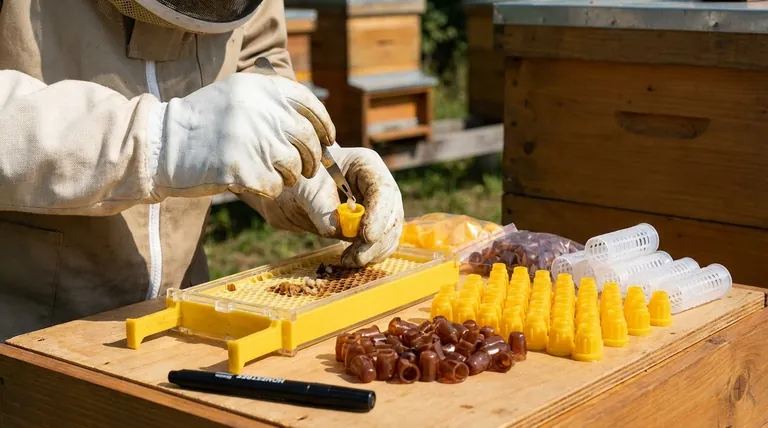The creation of a queen bee is a matter of nurture, not nature. Queen bees are raised from the same fertilized female eggs that produce worker bees. The colony determines a larva's destiny by feeding a select few an exclusive, protein-rich diet of royal jelly, which triggers their development into a queen.
The fundamental difference between a worker and a queen is not genetic, but nutritional. By controlling a larva's diet and environment, beekeepers can leverage the hive's natural process to raise queens on demand.

The Foundation: One Larva, Two Destinies
To understand queen rearing, you must first grasp the biological mechanism that makes it possible. A colony's ability to create a new queen is a core survival trait.
The Genetic Starting Point
All female bees, whether worker or queen, hatch from identical fertilized eggs. Their genetic makeup gives them the potential to become either caste. The path they take is determined entirely by external factors after they hatch.
The Nutritional Switch
For the first 2-3 days, all female larvae are fed royal jelly, a secretion from the glands of young nurse bees.
Larvae destined to be workers are soon weaned onto a mixture of pollen and honey called "bee bread." Larvae chosen to be queens are fed a continuous, abundant diet of royal jelly for their entire larval stage. This exclusive diet is what activates the developmental pathways to become a sexually mature queen.
A Critical Developmental Window
The decision to make a queen must happen early. The larva must be placed on a pure royal jelly diet before it is about three days old.
Beekeepers have found that for the best results, the larva should be less than 24 hours old. After this point, even brief exposure to a worker diet can inhibit full queenly development.
The Practice of Queen Rearing: Grafting
While colonies can raise their own "emergency" queens, beekeepers who want to scale their operations or improve their stock use a technique called grafting.
What is Grafting?
Grafting is the manual process of transferring a chosen larva from its original honeycomb cell into an artificial queen cell cup. This allows a beekeeper to select larvae from a specific mother queen known for desirable traits.
The Goal of Grafting
The primary goal is control. Grafting allows a beekeeper to raise dozens or even hundreds of queens with known genetics, selecting for traits like honey production, gentleness, or disease resistance.
The Technique: A Delicate Operation
Using a special grafting tool, the beekeeper carefully scoops a tiny larva out of its cell. The key is to lift the larva with its small bed of royal jelly, without touching or damaging its fragile body.
This larva is then gently placed into the bottom of a plastic or wax queen cup, which will be introduced to a "cell-builder" colony to be cared for.
Understanding the Trade-offs
Grafting is a powerful technique, but it is not without its challenges. It is a skill that requires precision and practice.
The Skill Requirement
Grafting is an art. It demands excellent eyesight, a steady hand, and a gentle touch. Many first-time attempts fail simply because the larvae are damaged during transfer.
Risk of Rejection
Success is not guaranteed even with a perfect graft. The cell-builder colony, which is a strong, queenless hive full of nurse bees, may reject the introduced larvae for various reasons.
Environmental Sensitivity
Larvae are extremely vulnerable to drying out. The entire grafting process must be done quickly in a warm, humid environment to prevent the larvae from desiccating and dying.
Making the Right Choice for Your Goal
Understanding how queens are made allows you to choose the right technique for your specific beekeeping needs.
- If your primary focus is simply replacing a lost queen: You can often let the bees manage it themselves by performing a "split," which encourages the colony to raise its own emergency queen from existing larvae.
- If your primary focus is improving genetics or expanding your apiary: Learning to graft is the essential skill for producing a high volume of quality queens from your best stock.
Mastering the process of raising queens is the key to moving from simply keeping bees to truly managing them.
Summary Table:
| Aspect | Worker Bee | Queen Bee |
|---|---|---|
| Diet | Bee bread (pollen & honey) | Exclusive royal jelly |
| Development | Sterile female | Sexually mature female |
| Rearing Method | Natural colony process | Grafting by beekeeper |
Ready to elevate your beekeeping operation?
Mastering queen rearing is essential for improving hive genetics, honey production, and disease resistance. HONESTBEE supplies commercial apiaries and beekeeping equipment distributors with the high-quality tools needed for successful grafting and queen management.
Contact HONESTBEE today to discuss your wholesale needs and discover how our equipment can help you produce superior queens.
Visual Guide

Related Products
- Jenter Queen Rearing Kit Complete Set for Bee Breeding
- Nicot Queen Rearing Kit for Beekeeping and Grafting in Nicot System
- No Grafting Queen Rearing Kit: System for Royal Jelly Production and Queen Rearing
- Brown Nicot Queen Cell Cups for Breeding Queen Bees Beekeeping
- Plastic Chinese Queen Grafting Tool for Bee Queen Rearing
People Also Ask
- What happens to the colony population during the 5–6 weeks after a new queen emerges? Understand the Natural Dip and Rebound
- What genetic pathways differ in QE-queens? Unlocking the Master Controls of Queen Bee Biology
- How long does it take for a new queen to emerge, mate, and lay eggs? A Beekeeper's 10-14 Day Guide
- Why is raising queens beneficial for beekeepers? Gain Control Over Genetics and Costs
- What is the timeline for queen breeding? A 28-Day Guide from Egg to Laying Queen



















